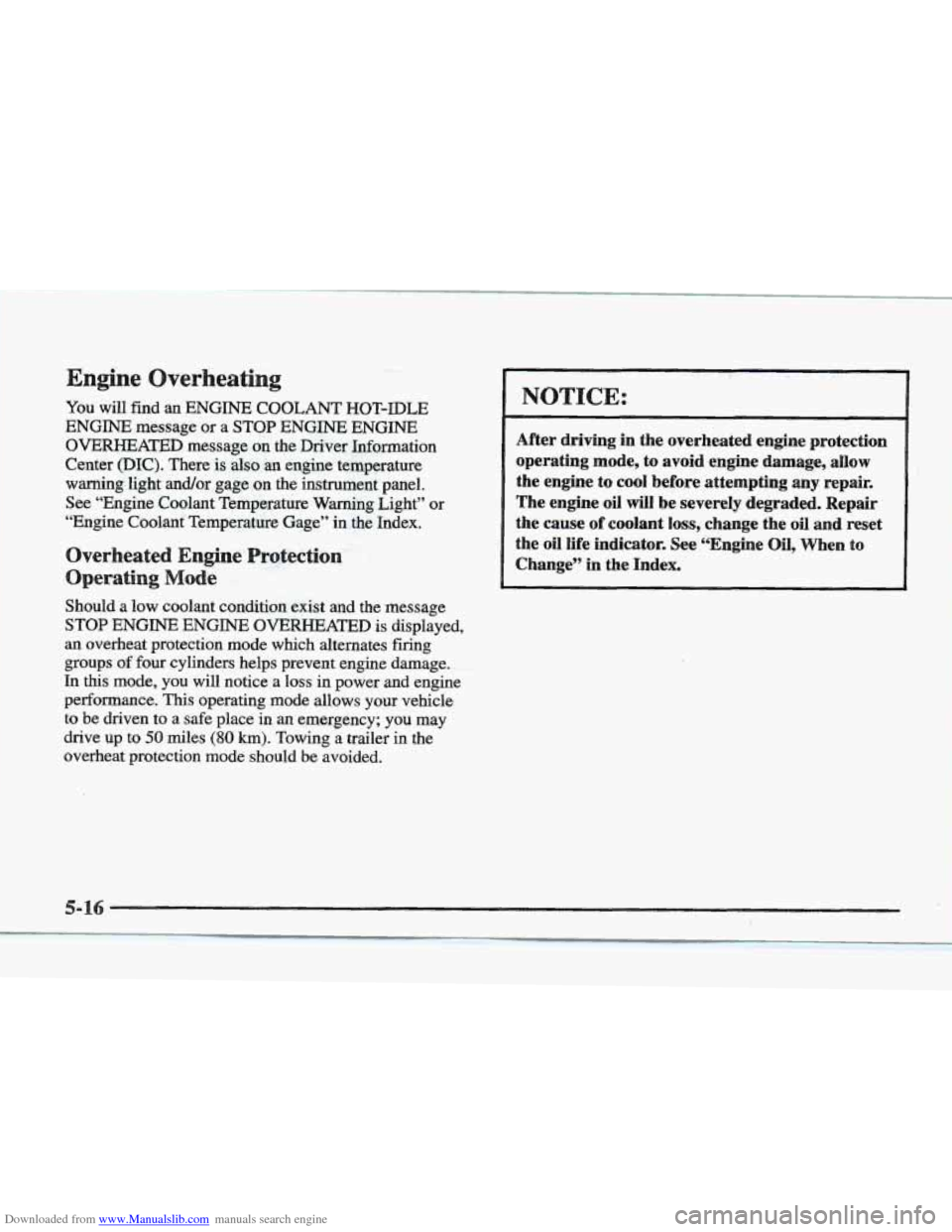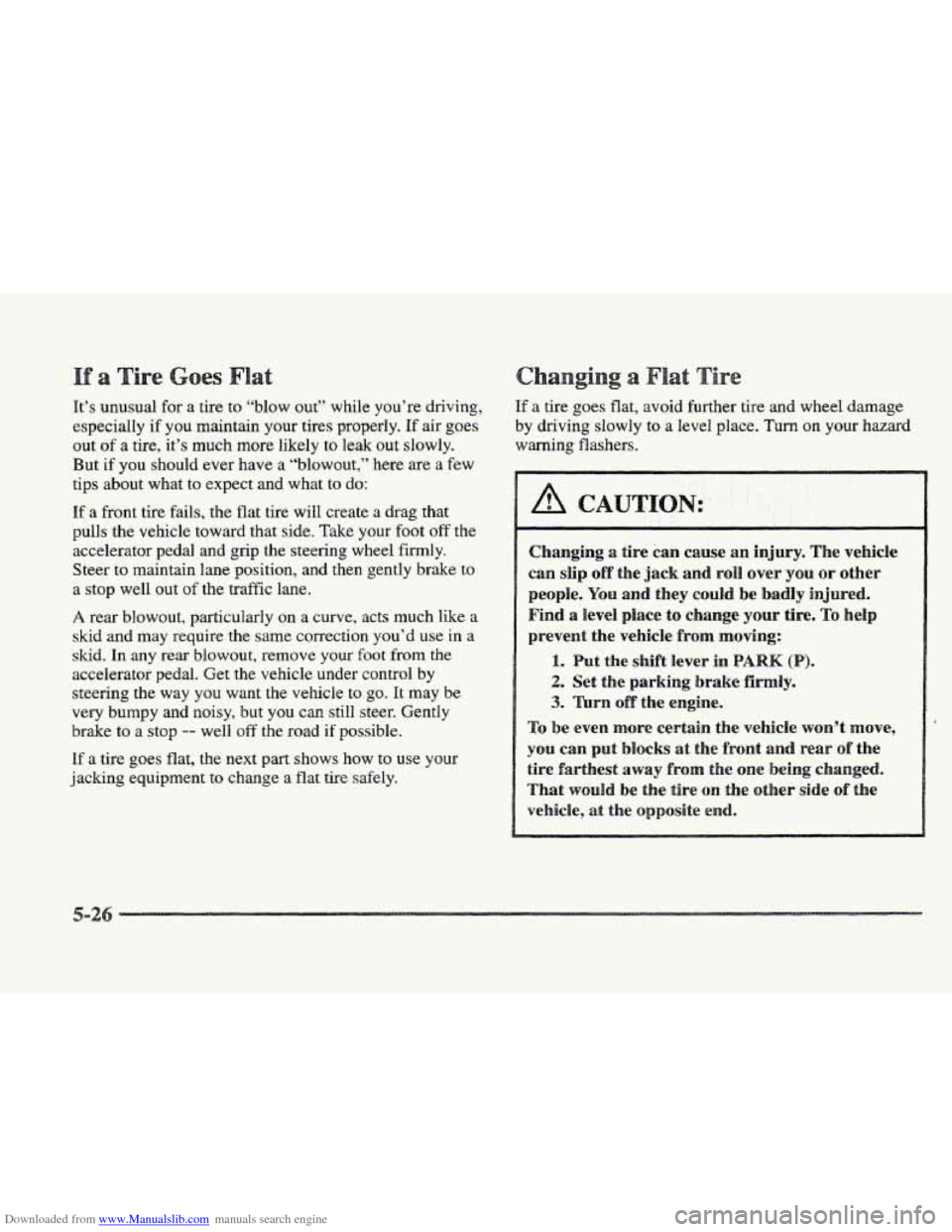Page 237 of 361
Downloaded from www.Manualslib.com manuals search engine FrOne TQ
Tow Limits -- 35 mph .(56 kph), 25 miles (40 km) NOTICE:
Do not tow with sling type equipment or
fascidfog lamp damage will occur. Use wheel-lift
or car-carrier equipment. Additional ramping
may
be required for car-carrier equipment. Use
safety chains and wheel straps.
Towing a vehicle over rough surfaces could
damage a vehicle. Damage can occur from vehicle
to ground or vehicle to wheel-lift equipment. To
help avoid damage, install a towing dolly and
raise the vehicle until adequate clearance is
obtained between the ground and/or
wheel-lift equipment.
Do not attach winch cables or J-hooks to
suspension components when using car-carrier
equipment. Always use T-hooks inserted
in
the T-kook slots.
Page 239 of 361
Downloaded from www.Manualslib.com manuals search engine NOTICE:
Do not tow with sling type equipment or rear
bumper valance damage will occur. Use wheel-lift
or car-carrier equipment. Additional
ramping
~ may be required for car-carrier equipment. Use
safety chains and wheel straps.
Towing
a vehicle over rough surfaces could
damage a vehicle. Damage can occur
from vehicle
to ground
or vehicle to wheel-lift equipment. To
help avoid damage, install
a towing dolly and
raise the vehicle until adequate clearance is
obtained between the
ground and/or
wheel-lift equipment.
..ti P J y..;
Do not attach winch cables or J-hooks to
suspension components when using car-carrier
equipment. Always use
W-hooks inserted in
the R-hook slots.
j
~
Page 241 of 361

Downloaded from www.Manualslib.com manuals search engine . -.-
You will find an ENGINE COOLANT HOT-IDLE
ENGINE message or a STOP ENGINE ENGINE
OVERHEATED message on the Driver Information
Center
(IDIC). There is also an engine temperature
warning light andor gage on
the instrument panel.
See “Engine Coolant Temperature
Warning Light” or
“Engine Coolant Temperature Gage” in the Index.
Overheated Engine Protection
Should a low coolant condition exist and the message
STOP ENGINE ENGINE OVERHEATED is displayed,
an overheat protection mode which alternates firing
groups
of four cylinders helps prevent engine damage.
In this mode, you will notice a loss in power and engine
performance.
This operating mode allows your vehicle
to be driven to
a safe place in an emergency; you may
drive up to
50 miles (80 km). Towing a trailer in the
overheat protection mode
should be avoided.
NOTICE:
After driving in the overheated engine protection
operating mode, to avoid engine damage, allow the engine to cool before attempting
any repair.
The engine
oil will be severely degraded. Repair
the cause of coolant loss, change the
oil and reset
the
oil life indicator. See “Engine Oil, When to
Change” in the Index.
Page 243 of 361

Downloaded from www.Manualslib.com manuals search engine If you get the overheat warning but see or hear no
steam,
the problem may not be too serious. Sometimes
the engine can get a
little too hot when you:
Climb a long hill on a hot day.
Stop after high-speed driving.
Idle for long periods in traffic.
Tow
a trailer.
If you get the overheat warning with no sign of stem,
try this for
a minute or so:
I. Turn off your air conditioner.
2. Dial temperature control to the highest heat setting
and open the window, as necessary.
otherwise, shift
to the highest gear while
driving
-- OVERDRIVE (@) or THIRD (3).
3. If you’re in a traffic jam, shift to NEUTRAL (N);
If you no longer have the overheat warning, you can
drive. Just to be safe, drive slower for about IO minutes.
If the warning doesn’t come back on, you can
drive normally.
If the warning continues, pull over, stop and park your
vehicle right away.
If there’s still no sign of steam, YOU can idle the engine
for two
or three minutes while you’re parked, to see if
the warning stops. But then, if you still have the
warning, turn off the engine and get everyone out of the
vehicle until it cools down. Also, see “Overheated
Engine Protection Operating Mode” listed previously in
this section.
You may decide not to lift the hood
but to get service
help right away.
Page 251 of 361

Downloaded from www.Manualslib.com manuals search engine ir s
It’s unusual for a tire to “blow out’’ while you’re driving,
especially if you maintain your tires properly.
If air goes
out of a tire, it’s much more likely to leak out slowly.
But if you should ever have a ”blowout,” here
are a few
tips about what to expect and what to
do:
If a front tire fails, the flat tire will create a drag that
pulls the vehicle toward that side. Take your foot off the
accelerator pedal and grip the steering wheel firmly.
Steer to maintain lane position, and
then gently brake to
a stop well out of the traffic lane.
A rear blowout, particularly on a curve, acts much like a
skid and may require the same correction you’d use in a
skid. In any rear blowout, remove your foot from the
accelerator pedal. Get the vehicle under control by
steering the way you want the vehicle to go. It may be
very bumpy and noisy, but you can still steer. Gently
brake to a stop -- well off the road if possible.
Hf a tire goes flat, the next part shows how to use your
jacking equipment
to change a flat tire safely. If
a tire
goes flat, avoid further tire and wheel damage
by driving slowly to a level place.
Turn on your hazard
warning flashers.
-2
Page 257 of 361
Downloaded from www.Manualslib.com manuals search engine 6. Remove any rust or dirt
from the wheel bolts,
mounting surfaces
and
spare wheel.
7. Replace the wheel nuts
with the rounded end of
the nuts toward the
wheel. Tighten each nut
by hand until the wheel
is held against the hub.
Page 263 of 361
Downloaded from www.Manualslib.com manuals search engine Spinning yoas wheels can destroy parts of your
vehicle as well as the tires. If you spin the wheels
~QQ fast while shifting your transaxle back and
forth,
you can destroy your transaxle.
For
information about using tire chains on your vehicle,
see “Tire Chains” in the Index.
First, turn your steering wheel left and right. That will
clear the area around your front wheels.
You should turn
your traction control system off. (See “Traction Control
System”
in the Index.) Then shift back and forth
between
REVERSE (R) and a forward gear, spinning the
wheels as little as possible. Release the accelerator pedal
while you shift, and press lightly
on the accelerator
pedal when the transaxle
is in gear. If that doesn’t get
you
out after a few tries, you may need to be towed out.
If you do need to be towed out, see “Towing Your
Vehicle” in the Index.
Page 274 of 361
Downloaded from www.Manualslib.com manuals search engine en t
If the oil is at or below the ADD line, then you’ll need
to add at least one quart of oil. But you must use the
right kind.
This part explains what kind of oil to use. For
crankcase capacity, see “Capacities and Specifications”
in the Index.
Pull out the dipstick and clean it with a paper towel or
cloth, then push it back in all the way. Remove it again,
keeping the tip down,
and check the level.